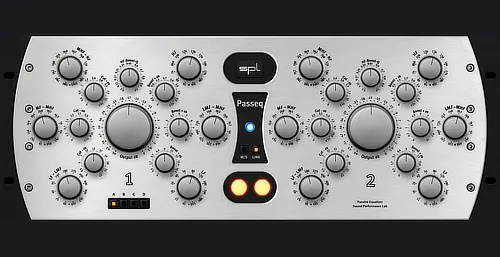The SPL PassEQ Passive Mastering Equaliser is a dual-channel, passive equaliser. The SPL PassEQ Passive Mastering Equaliser – Model 1650/1654 is a new revised edition of the well known SPL Passeq – Model 2595. Both units are based on our 120V Rail Technology. The new SPL PassEQ Mastering Equaliser features the same high-quality characteristics as the previous model, though it was revised and optimised to fulfill all requirements of a Mastering Equaliser.
The SPL PassEQ Passive Mastering Equaliser of the first generation was the first passive equaliser which provides three separate frequency ranges for the boost and the cut stages. With 12 switchable frequencies per band, totalling 36 boost and 36 cut frequencies, the Passeq was the most powerful passive EQ system ever made. The new PASSEQ Mastering Equaliser features the same amount of cut and boost frequencies, though the choice of frequencies was changed, and the Q-factor was individually newly adjusted for every selectable frequency with an optimal coil, condenser, resistor combination.
Each boost and cut frequency now got an individual optimised Q factor. Especially the mid bands are much more harmonious for working on program material than they were on the previous model. When we were fine-tuning, through component selection, within countless listening sessions, the focus was on receiving musically sounding curves, which are clearly on par with legendary devices like the Pulteq EQ from the decades of the 1950’s and 60’s, but without all disadvantages of a 60-year-old original, like a high noise level and most of all a very limited choice of frequencies.
All passive filter components (variable resistor, capacitor and coil) deliver excellent sonic characteristics. An important part of this process is played by coil and condenser loading and saturation characteristics. The resulting inertia in contrast to the characteristically extremely fast reaction of active filters is the reason for pleasant, beneficial sonic characteristics. We tend to perceive these attributes in terms of an increased suppleness and transparency, with perceptibly improved, silky highs and warm and punchy basses. Another highlight of the new SPL PassEQ Passive Mastering Equaliser is the HF+ Band, which was expanded with the frequencies 25kHz and 35kHz, sounding so incredibly good, that you don’t want to turn it off anymore.
Thanks to the big detented output control, you can increase or attenuate the output level by 10dB, to reach following devices with the perfect desired level. This is important, especially when it comes to mastering. A fader ranging from 0dB to limitless, like the previous model provided, would not be helpful in this case. With the PASSEQ you can also adjust the parameters Gain, Q (HF +) and Output in 41 steps with the detented potentiometers. All other parameters can be adjusted with 12-position switches. Thanks to these switches and detented potentiometers, a precise recall is very easy to realise.
In addition to that, the handling of the SPL PassEQ Passive Mastering Equaliser was improved through small corrections of the positioning and naming of the control elements. Like all new SPL Mastering devices, the new SPL PassEQ Passive Mastering Equaliser provides an Auto Bypass. Of course, each of the two channels can also be manually activated or deactivated with the big, illuminated pushbuttons. Thanks to the Auto Bypass, this can also be realised automatically in a freely selectable time frame.
Filter Types
There is basically only one type of filter used in the PASSEQ: The bell-filter or peak-filter. But since the centre frequency of the peak-filter, concerning the HF and LF bands, is only marginally within the perceptible hearing range, these filters auditorily and visually rather correspond to shelf-filters.
Shelf Filters
A shelf filter increases or decreases the energy of all frequencies above or below a chosen frequency. Depending upon the direction of processing one refers to high frequency (HF) or low frequency (LF) shelf filters. Beginning with the threshold frequency, the frequency band is boosted or cut much like a shelf. The maximum boost or cut achieved at the point furthest from the threshold frequency. The threshold frequency is usually about 3dB less (with the overall increase set to maximum). This gives the typical rising form of the shelf filter’s response curve.
Peak Filters
A peak filter boosts or cuts a chosen frequency‘s energy with a maximum amplitude and a definable frequency range around this frequency with a fall off of up to 3dB to both sides. The chosen frequency with the maximum amplitude is called centre frequency—it takes place in the middle at the peak of the response curve. The response curve forms a bell, thus peak filters are also often referred to as bell filters.
Bandwidth
The width of a frequency range or band is musically defined in octaves. The technical counterpart to this is the “Quality” of a filter, and the abbreviated “Q” is the most common value for the bandwidth of a filter. A high Q value means a narrow bandwidth while a smaller Q factor corresponds to a wider one:
- Bandwidth 2 Octave: 0.7 Q
- Bandwidth 1 1/3 Octave: 1 Q
- Bandwidth 1 Octave: 1.4 Q
- Bandwidth 1/2 Octave: 2.8 Q




